Munich is an amazing city in which you can easily spend several days. Hey, some people spend their entire lives here! But in case you would like to venture beyond the city limits, here are some suggestions for day trips from Munich.
All suggestions are suitable for public transportation. You could also drive, of course. However, depending on the weekday and season, driving is not advisable – too many cars on the road. Trains will often be packed on weekends, but even if you don’t get a seat, at least you will zoom past the traffic jams and not have to worry about parking. (If you must have a seat, travel in first class.)
I also include three of the most popular day trips from Munich, but recommend doing these as a group tour by coach.
For a rainy day, check out my list of 35 museums in Munich.
By S-Bahn
S-Bahns are the suburban trains that operate in Munich and other metropolitan areas. They go beyond the city limits, but not quite as far as a „real“ train.
Munich’s S-Bahns are red, and each line starts with an S. There are eight S-Bahn lines in total. Between Ostbahnhof (Munich East train station) and Donnersbergerbrücke (two stops west of Munich central train station), all lines share the same tracks before branching off to their respective final destinations.
Freising
The oldest town in Upper Bavaria, Freising was founded in 739 CE. The resident Bishop of Freising was one of the richest and most powerful people in Europe. Thus, Freising was a centre of power – until Munich surpassed it. Today it is a pretty town with a striking cathedral, decorated by the Asam brothers, and an amazing museum.
How to get there: Catch S1 to Freising or a regional train towards Landshut.
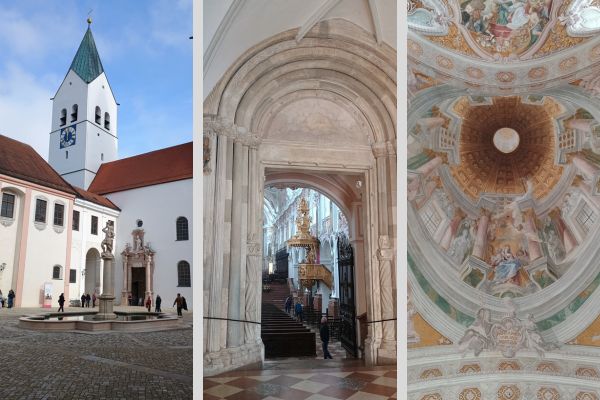
Dachau Concentration Camp
The Nazis set up their first concentration camp, in Dachau, within two months of coming to power. The camp was only liberated in April 1945. Today, you can tour the Dachau concentration-camp memorial site on your own (audio guides are available) or with a guide.
How to get there: Catch S2 to Dachau and then bus 726 towards „Saubachsiedlung“ to reach the memorial site.
Lake Starnberg
One of the many lakes left by retreating glaciers at the end of the last ice age, Lake Starnberg makes for a pretty outing. On a clear day, you will see the Alps in the distance, including Germany’s highest peak, the Zugspitze. The lakefront, just a few steps from the station, offers lovely walking opportunities, or you could catch one of the boats for a mini-cruise on the lake. Starnberger Eiswerkstatt, a great ice-cream shop, is located in the square next to the church. There is a nice walk (running shoes sufficient) from Starnberg through the Maisach gorge to Feldafing, where you can visit the Rose Island. In the summer, the lake is warm enough for a swim.
How to get there: Catch S6 to Starnberg.
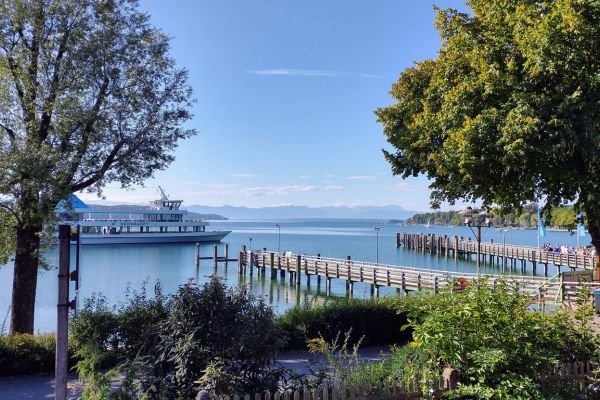
Lake Ammersee and Andechs Monastery
Located west of Lake Starnberg, Lake Ammersee is one of the „big five“ lakes. From Herrsching, you can catch a bus or hike up the hill to the (active) Andechs Monastery to enjoy the local beer. Alternatively, catch a boat for a mini-cruise on the lake. Once a year, the town of Diessen on the west shore hosts a (very busy) ceramics market.
How to get there: Travel to Herrsching by S8. Getting to Diessen is a little more complicated and involves a change of trains in Weilheim. Alternatively, travel to Herrsching and hop on a boat across the lake.
Therme Erding
For something completely different, spend a few hours in Therme Erding, the largest thermal spa in the world, near the airport. To avoid hordes of screaming kids, come on a weekday morning outside of school holidays.
How to get there: Catch S2 to Altenerding plus a bus or walk from the S-Bahn stop.
By Regional Train
A number of interesting destinations are just a one- or two-hour train ride away. If you are using regional trains only (i.e., the slow ones), you can use the Bayern-Ticket on many routes. If you are headed towards Garmisch/Kochel, the Regio-Ticket Werdenfels is a cheaper option, but cheeky DB doesn’t provide any info in English …
Trains to most of these places run every hour or maybe even every half-hour. Download the DB Navigator app to check schedules. Unless specified otherwise, catch all trains from Munich central station.
Salzburg
Sitting right on the Austrian border, Salzburg is just a 2-hour train ride away. From Salzburg central station, you can walk into town in about 20 minutes, or catch a bus. Explore the little alleys, visit the fortress or a museum, enjoy a piece of apple strudel … In winter, Salzburg is known for its Christmas market (though honestly, I found it underwhelming). Bring your passport! There are police checks on the trip back to Munich.
How to get there: Catch BRB RE5 to Salzburg (from Munich central or Munich East station) if you are travelling with the Bayern-Ticket. The EC, RJ and Westbahn trains will take you to Salzburg as well, but you cannot use the Bayern-Ticket.
Lake Chiemsee & Herrenchiemsee Palace
If you don’t have enough time to visit Neuschwanstein, King Ludwig II. built another palace on Herrenchiemsee island in Lake Chiemsee. You can take a guided tour of the palace state rooms, visit the King Ludwig II. museum or admire the palace from outside and walk in the gardens. Especially in high season, buy tickets ahead of time. Note that boat tickets are extra. You could spend the night in Prien and continue to Salzburg the next day. If you are not interested in the palace, I would suggest going to one of the other lakes on this list, as they are prettier.
How to get there: Catch a Salzburg-bound train from Munich central or East to Prien am Chiemsee, walk to the jetty (about 15 minutes) and catch a boat to Herreninsel.
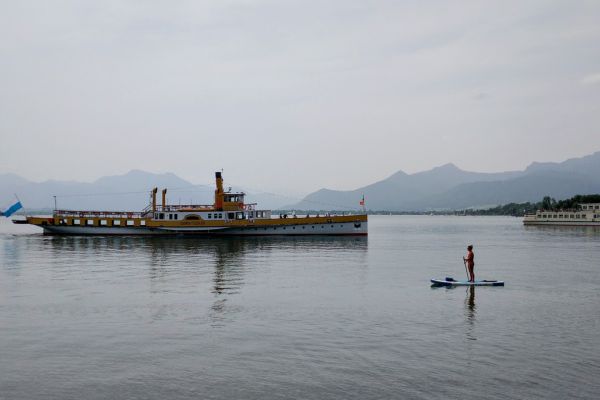
Augsburg
If you think that Munich has lots of history, check out Augsburg. This pretty little city was founded by the Romans 2,000 years ago. It’s just a 30-minute train ride from Munich. Augsburg was home to the Fugger family, who were among the richest people in Europe for a while. In 1521, Jakob Fugger founded the Fuggerei, the world’s oldest social housing complex. It is still social housing today – the buildings have been updated, but the rent remains unchanged. You can visit four museums within the complex. Other than that, Augsburg is a pleasant place to stroll around and explore the small shops.
How to get there: Catch RB86 if using the Bayern-Ticket. There are frequent ICE trains between Munich and Augsburg, but they require a regular ticket.
Lake Tegernsee
This gorgeous lake and the eponymous town are a favourite hangout for Munich’s population. Let’s be clear, the place is expensive and will be very busy, especially on weekends. But rightfully so, for it’s lovely, especially on a sunny day. You can walk by the lake, visit the Olaf Gulbransson Museum, enjoy ice-cream and just overall consider yourself in heaven. Of course, the town has its own brewery as well.
With appropriate footwear (running shoes are the bare minimum), you could alight at Gmund and take the „Höhenweg“ to the town of Tegernsee. You will pass a few pretty little cafés on the way and enjoy beautiful views of the lake.
Gmund, by the way, is home to the high-end Gmund paper factory. You can purchase their products on site, tour their factory and eat at their restaurant.
How to get there: Catch BRB RB57 to Tegernsee (or Gmund).
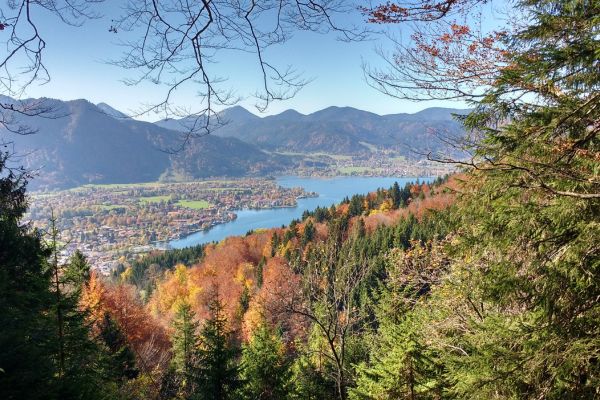
Garmisch-Partenkirchen & Zugspitze
Zugspitze is Germany’s highest mountain at almost 3,000 metres, and Garmisch, the town at its foot, once hosted Olympic competitions. To help you reach the Zugspitze summit, there are cable-cars and a cogwheel train. Tickets are super expensive and lines are ridiculously long. Needless to say, it only makes sense to go up when the weather is nice.
Alternatively, consider visiting the Partnachklamm, the gorge of the Partnach river. This is an easy walk (admission fee), suitable for small children, but it’s a few degrees colder in the gorge and often very wet. You can walk in and out, or return via Graseck.
How to get there: Take RB6 to Garmisch-Partenkirchen. From the station, catch bus 2 (direction „Klinikum“) to the „Skistadion“ stop to reach the Partnach gorge entrance.
Lake Kochel & Franz Marc Museum
Franz Marc, one of Germany’s best-known expressionist painters, lived in the beautiful villa that today houses a museum named after him. It is just a few steps from the shores of Lake Kochel, where you can swim in summer. After visiting the museum, you could catch a bus that goes past the very scenic Lake Walchensee to Garmisch-Partenkirchen, have a look around town and catch a direct train back to Munich. With a Bayern- or Werdenfels-Ticket, you can hop off the bus along the way without worrying about paying for yet another ticket when you continue your journey. Just make sure to check the schedule, as buses are not that frequent.
Alternatively, Lenas Café im Schusterhaus near the train station is a great spot to relax.
How to get there: Catch RB66 to Kochel and walk from there (approx. 15 minutes).
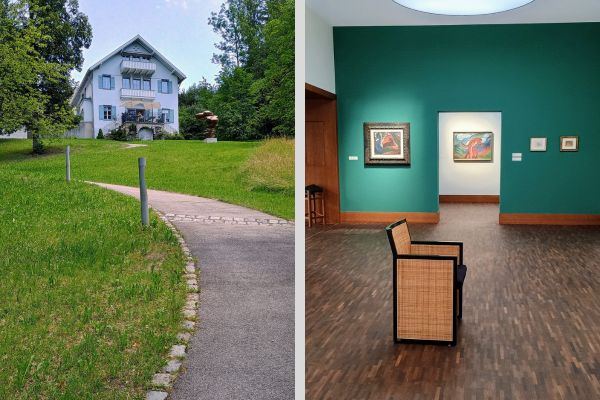
Bernried & Buchheim Museum
You’ve heard about „Das Boot“, right? The guy who wrote the book, Lothar-Günther Buchheim, was an artist whose collection is now displayed in his own museum at Bernried. Bernried is a small and pretty town on Lake Starnberg, just a short ride from the town of Starnberg. From the museum, you can walk along the lakeshore to Tutzing and catch an S-Bahn or train back to Munich. Running shoes are sufficient, though the path may be muddy after rain.
How to get there: Catch RB66 towards Kochel, alight at Bernried station and walk about 15 minutes to the museum.

By Group Tour
I am not the biggest fan of group tours, but they do make sense in some cases – simply because you are covering so much ground and don’t want to have to deal with parking etc. These are full-day tours that start at 7:30ish and return to Munich 10-12 hours later.
You can visit all of these places on your own as well, but to avoid reduce stress, I would recommend overnight trips.
Neuschwanstein & Linderhof Castles
Two castles built by King Ludwig II., who nearly ruined Bavaria in the process, but created some of the state’s biggest tourist attractions. In season, the castles sell out weeks in advance, so a tour may be your only chance to even get a ticket.
Neuschwanstein, „the Disney castle“, is the more famous one, but most visitors think that Linderhof is prettier. Note that you cannot visit Neuschwanstein on your own time! You will have to join a guided tour that is only about 30 minutes long.
The drive from Munich is approx. 2.5 hours. When booking your tour, check the exact itinerary and whether admission tickets for the castles are included in the price.
It is also possible to visit Neuschwanstein and Linderhof on your own, or in combination with the Romantic Road (see below). See my mini-guide for both destinations for information.
Romantic Road
Tours of the Romantic Road from Munich typically stop at Harburg Castle and at Rothenburg ob der Tauber.
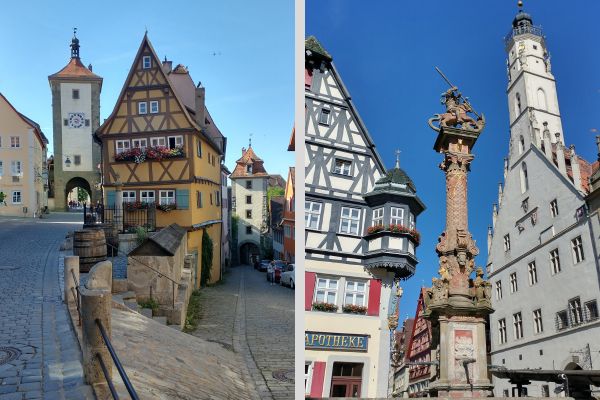
Rotherburg ob der Tauber is very pretty, but it’s also very small and a three-hour drive from Munich. On this tour, you will spend a lot of time on the coach – more than you will have to explore your destinations.
It is also possible to visit the Romantic Road on your own, or in combination with the Neuschwanstein and Linderhof castles (see above). See my mini-guide for both destinations for information.
Berchtesgaden, Oversalzberg & Eagle’s Nest
Set in a beautiful corner of Germany, the town of Berchtesgaden is worth a visit on its own, but tours focus on the Obersalzberg (Nazi documentation centre) and Kehlsteinhaus (Eagle’s Nest, Hitler’s Alpine retreat at 1,800 m/6,000 ft elevation). In case of poor weather conditions, the Kehlsteinhaus may be inaccessible. In this case, tours include a visit of the local salt mine.
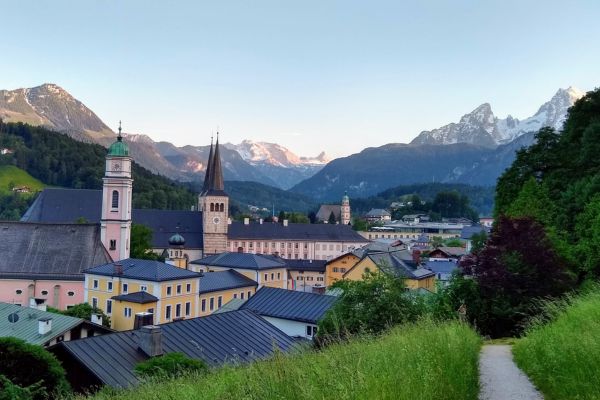
If you would like to visit on your own, see my Berchtesgaden mini-guide with suggested itineraries.

4 Kommentare